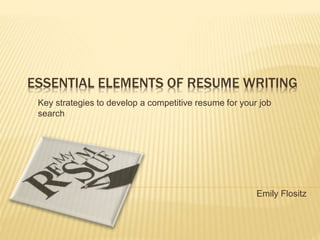
Essential elements of resume writing
- 1. ESSENTIAL ELEMENTS OF RESUME WRITING Key strategies to develop a competitive resume for your job search Emily Flositz
- 2. PURPOSE OF A RESUME The main purpose of your resume is to get you the job interview During the job interview it can serve as a guide for conversation between candidate and employer There is no exact science to creating a resume; in fact it is more of an art form tailored to how you want to be perceived by your potential employers, showcasing your knowledge, abilities and skills as they relate to the job opening
- 3. KEY SECTIONS OF A RESUME The first step to writing your resume is to know your audience and to know how you want to market yourself Resume must-have’s include: Contact information Objective/career summary Education Work experience Optional sections include: Summary of Skills Volunteer Work Technical Skills Honors and Awards Memberships and Affiliations Relevant Coursework
- 4. CONTACT INFORMATION A full formal name is traditional, but it is acceptable to use the name you prefer to be called (ex. Jessica to “Jessie”) Your name should be bold and in a larger font, typically 16pt-20pt Essential contact points are Phone number, E-mail address and a physical address (one that is best to contact you at) Ensure that the e-mail address provided is professional and simple (ejones@gmail.com rather than topgun47@aol.com). Student e-mail address should suffice, however, upon graduation consider obtaining your own e-mail account specifically for job hunting and to separate from student identity and to stay organized in your job search Remember to provide a professional sounding voicemail greeting for potential employers that clearly identifies your name If your resume is more than one page, be sure to provide your contact information as a header on all subsequent pages Example: Jonathan “Jon” Davis Phone: (407) 555-4321 / E-Mail: jdavis@gmail.com 123 Main St. Orlando, FL 32701
- 5. OBJECTIVE/CAREER SUMMARY An objective statement is typically used for students or alumni and career changers It gives your resume clear direction and focus It will consist of a short and concise statement that identifies: Position you are seeking Field of interest Your strongest relatable skills for the job (What you can bring to the position) A career summary is often used for experienced professionals It summarizes and highlights your relevant experiences and qualifications obtained through similar work experiences, transferrable into new job prospects Designed to captivate your audience and communicate your value as an employee Can be in paragraph form, bullet statements or a combination of both It identifies: Your career profile Brief statements describing work history Skills and abilities that support desired field of work Technical skills or qualifications (licenses, certifications, etc.)
- 6. EDUCATION As a student or alumni, this section may need to be provided before listing work experience Identify your degree, school name, any concentrations, dates enrolled and, if desired, your GPA High school diploma/information is typically unnecessary at this stage of your professional development Example: 08/2008 – 05/2012 Bachelor of Science in Information Technology Seminole State College, Lake Mary, FL GPA: 3.77
- 7. EXPERIENCE This section is not limited to professional/paid work experience Volunteer work, research projects, internships, community service and the like can all be considered as “experience” Include dates of employment, job title, name of company, and location Follow this with 3-5 Bullet statements describing specific skills and responsibilities undertaken and developed in this experience Do not list references, they can be listed on a separate document to submit as needed Example: 01/2009 – Present Front Service Manager Publix, Orlando, FL Develop and monitor labor schedules of 25 employees Interact with customers, identifying their needs and if needed, resolve any customer service issues Supervise front end staff of cashiers, baggers, and support assistants
- 8. THE STAR METHOD To create your bullet statements for each work experience, try using the STAR Method: Situation – What situation have you confronted or handled? Task – List requirements of the situation; what needed to be done? Action Steps – What steps did you take to handle/resolve this situation? Results – What was the conclusion of the situation, and the impact of it on the company, agency, fellow employees, customers, etc.?
- 9. FORMATTING The most important thing to remember when formatting your resume is consistency; Find a style you like and stick with it throughout Each section that lists similar information (dates, title, company, location, bullet statements) should be formatted in the same style Keep it simple: Avoid any fancy or creative fonts, choose one that is easy to read and can easily transfer from sender to receiver (some fonts are not supported by other users’ programs) Typical font size for content is between 10pt -12pt Watch grammar and punctuation (If you end any bullet statements with a period, make sure to end all of them with a period) Try to stay with one page; Typical rule of thumb is one page for every 10 years of experience. Page margins, font sizes and line spacing can be adjusted List all experiences and education in Reverse Chronological (Most recent first, oldest last)
- 10. TIPS AND SUGGESTIONS Work on one section at a time; This will reduce stress and exhaustion If at any time you get stuck, move onto another section and come back to it later Start with the easy things; they require little effort/thought and can be completed quickly Get it all down, then go back through to polish it; have others review it several times to check for errors and fluidity Be sure to tailor your resume to each job posting so that only the relevant material are highlighted/incorporated Do not include salary history, age, gender, or personal information Have a career counselor review your resume, they are great asset with valuable resources! Don’t forget about aesthetics! Refrain from abstract coloring, fonts, paper, etc. Stick to professional looking whites, blacks, and grays